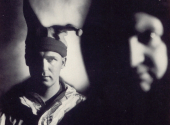
Milestones in Music History #49: The Dillinger Escape Plan, Calculating Infinity
Nothing could have projected us more into the future than Daft Punk, the protagonists of our last episode. Yet, if we turn our gaze to the music of the 2000s, we witness an interesting mutation in all genres. Taking hardcore and metal in particular, at the beginning of the 2000s a substantial evolution took place in these two genres, which turned the previous tradition upside down – and changed the rules of the game, forever. And leading this change was the mind-bending The Dillinger Escape Plan.
At the end of the 1980s, what was left of punk went into hardcore, and to this style was added a heavier component belonging to extreme metal, which had been developing at the beginning of the same decade. Very often the vocal parts were screamed and accompanied by incessant rhythms of double-bass drumming.
Guitars with riding riffs were interspersed with moments of breakdowns, in which a single instrument led the composition – an apparent tranquillity, eventually leading to the brutal (and sometimes bloody) mosh pit. This was how metalcore was born. The forerunners of the genre include bands such as Bad Brains, Black Flag and the legendary Black Sabbath, but also punk bands that mixed heavy metal influences, such as Exploited and Misfits.
Thus, in the early 1990s, the most irreverent elements of punk and heavy metal, or rather heavy hardcore, were spotted in Ohio, where one of the first metalcore scenes was born. Groups such as Ringworm and Integrity are considered the first to navigate this genre. In particular, Integrity's debut album, Those Who Fear Tomorrow, released in 1991, marked the beginning of the genre, and the use of breakdowns on the record was emulated by the entire subsequent music scene.
Metalcore also took its first steps in Philadelphia, with some bands, including Starkweather, who combined metal and hardcore, and Rorschach, who developed an interesting compositional discourse that mixed metalcore and noise, and from this mix genres such as mathcore were subsequently born and noisecore.
On the East Coast, metalcore seemed to be developing visibly; it had also caught on in Boston, thanks to Converge and Overcast. Also in New York, bands like Merauder, who had released their debut album (Master Killer) in 1996, Vision of Disorder and All Out War. Not far from New York – precisely in New Jersey, Morris Plains – The Dillinger Escape Plan was founded in 1997.
But let's take a step back for a moment. In fact, before becoming one of the first metalcore bands, the name under which The Dillinger Escape Plan debuted was Arcane. An extremely aggressive hardcore punk band that addressed political themes in their lyrics. After a few changes in compositional direction and line-up, it was the moment to choose a new name for the group.
Having been without a name for several months, they finally, after a suggestion from a friend of the band, who had seen the documentary about John Herbert Dillinger, the famous 1930s gangster who had robbed 24 banks and 4 police stations and was reported to have escaped from prison several times.
The name seemed to fit well with the band's temperament and intentions. Under this name, the eponymous debut EP was released, six tracks marking the entry of Adam Doll, Dimitri Minakakis, Chris Pennie, and Ben Weinman into the Olympus of metal. But that's not all.
Scrolling through song after song, different influences emerge, ranging from the hardcore punk of their roots ("I Love Secret Agents"), to experimental rock (songs like "Monticello" and "Three For Flinching (Revenge Of The Porno Clowns)" with an abundant touch of mathcore ("Proceed With Caution", "Caffeine" and "Cleopatra's Sling").
Soon after the release of the EP, the band went on tour, their first as The Dillinger Escape Plan. The following year, the second EP, Under the Running Board, was released. Seven minutes that take your breath away. An album that consisted of only three tracks ("The Mullet Burden", "Sandbox Magician" and "Abe the Cop"), with a more experimental and increasingly mathcore and metalcore orientation, which foreshadowed what was to come.
The band was meanwhile gaining popularity for their, shall we say, somewhat over-the-top approach, and the brutality of their live shows, in which everything happened. But also for their compositional originality and musical versatility. They achieved success, to the point that the Relapse Records label offered them a multi-record deal.
In addition, Nate Newton, after hearing their second EP, invited them to Canada for a tour with his band and Botch. In 1999, The Dillinger Escape Plan's debut album was released, the acclaimed and incredibly (justly) well-received Calculating Infinity. How to define it? A composite album, with elements of early hardcore punk, combined with grind, mathcore, experimental rock, and metalcore.
But I could stand here forever listing genre after genre. It would be better to listen to it. A work – or rather a masterpiece – that was certainly not fearfully composed. But it does provoke fear. Many argue that the album can be considered a pioneer of mathcore, or that it even founded the genre. The complexity of the musical composition is unique – sudden changes of rhythm, incorrect harmonisation, unexpected tonalities – and intentional.
As Weinman once stated, the intent was to tear up the music theory book. Go against some typical and canonical scales and rhythms. That is a brilliant idea. Maybe the aim was also to amaze, or simply to have some fun. When listening, what one perceives is shock, but fun. The entire album is to be enjoyed in one go. From the opening, the intense and wonderful "Sugar Coated Sour", to end with "Variations on a Cocktail Dress".
Mike Patton was one of the first to hear the album and, being delighted, he invited the group on tour with his Mr. Bungle. Shortly thereafter the band dismantled, and after various vicissitudes and many line-up changes it returned to play, remaining more or less active until 2017 – even surviving a very serious road accident.
But it was with Calculating Infinity that the band left its mark on experimental metal forever. By rights, the album is considered fundamental both for the band and for the genre of mathcore and metalcore, and The Dillinger Escape Plan is one of the most influential and important bands in the history of the most subversive and aggressive music.
The Dillinger Escape Plan changed the way of conceiving extreme metal, grind and core, combining the math component. They also made many listeners who were not accustomed to metal interested. And last but not least, they changed the rules of composition, astonishing and inspiring generations of musicians to come. Such a creative and inspiring force can be found in an electronic music genius on the West Coast in the late '90s, Flying Lotus, who will be featured in our next episode of Milestones.
What are the rules to be respected, and those that can be violated, in musical composition? When does the musician's freedom end? What can surprise us musically nowadays? And who else will "escape" musical stereotypes, as The Dillinger Escape Plan did?
Leave your opinion in the comments below!
If you have found an error or typo in the article, please let us know by e-mail info@insounder.org.





